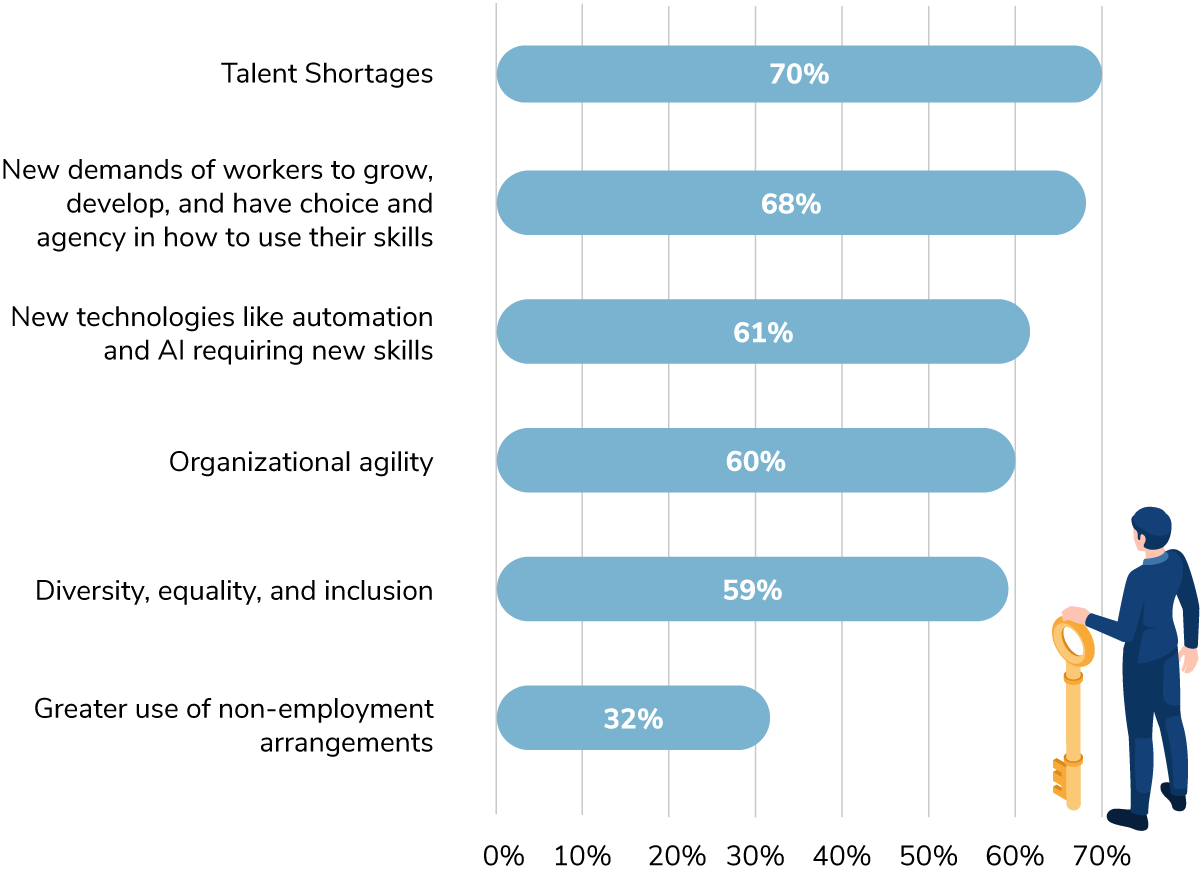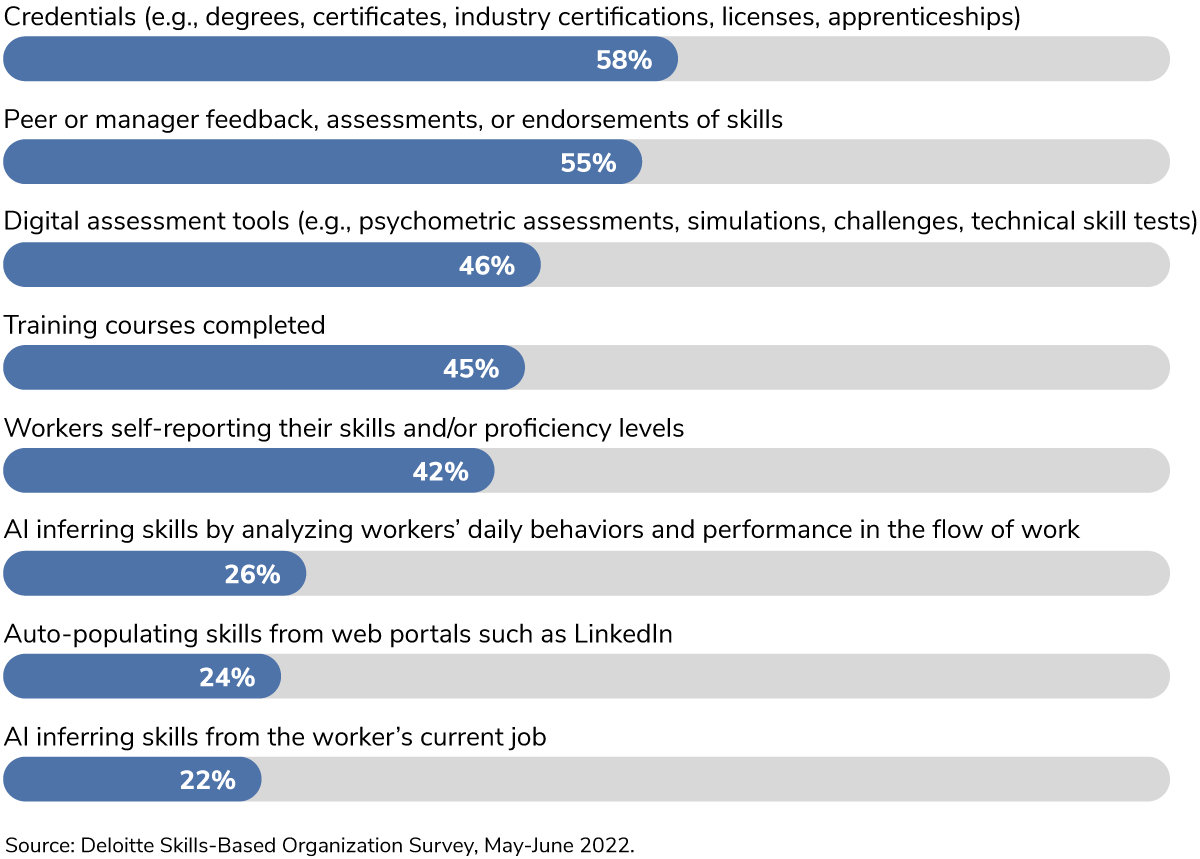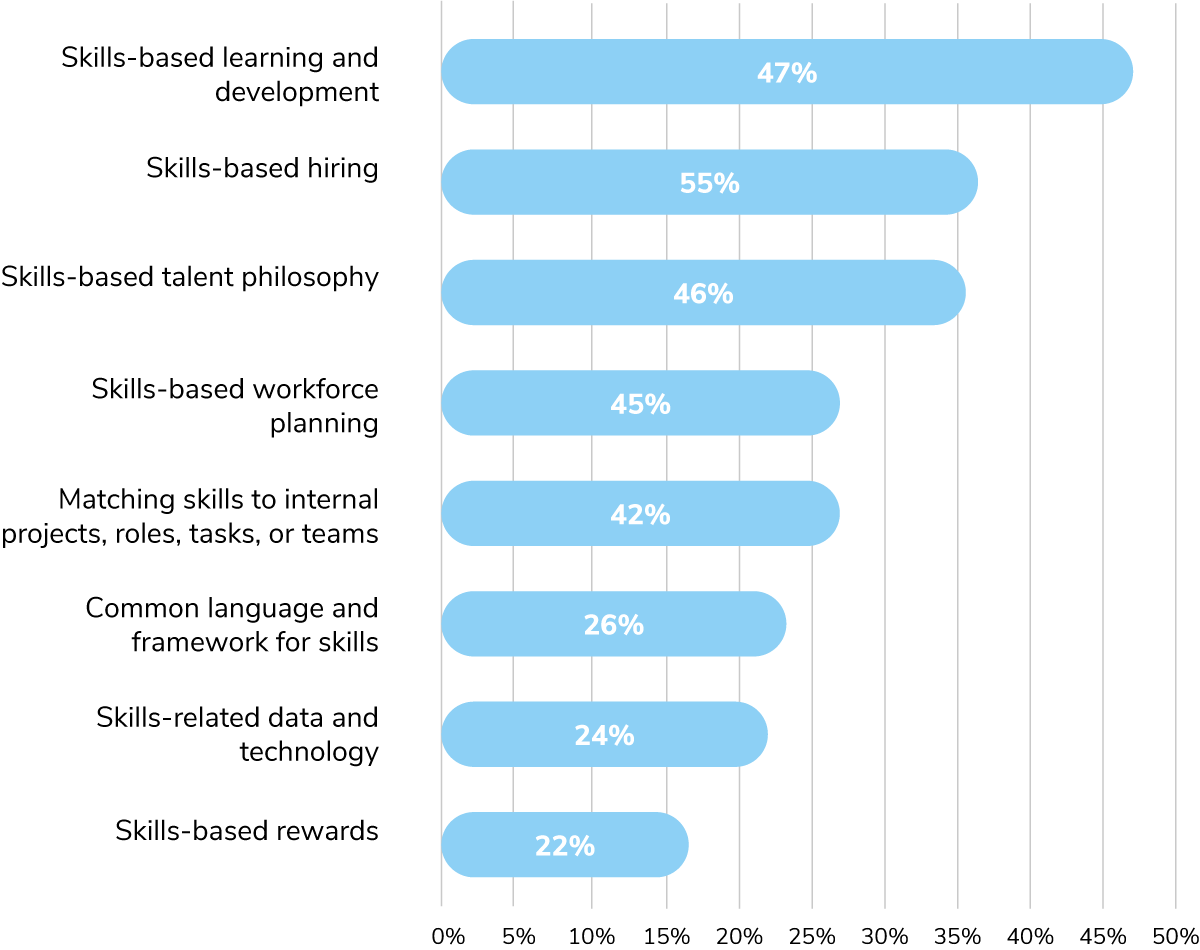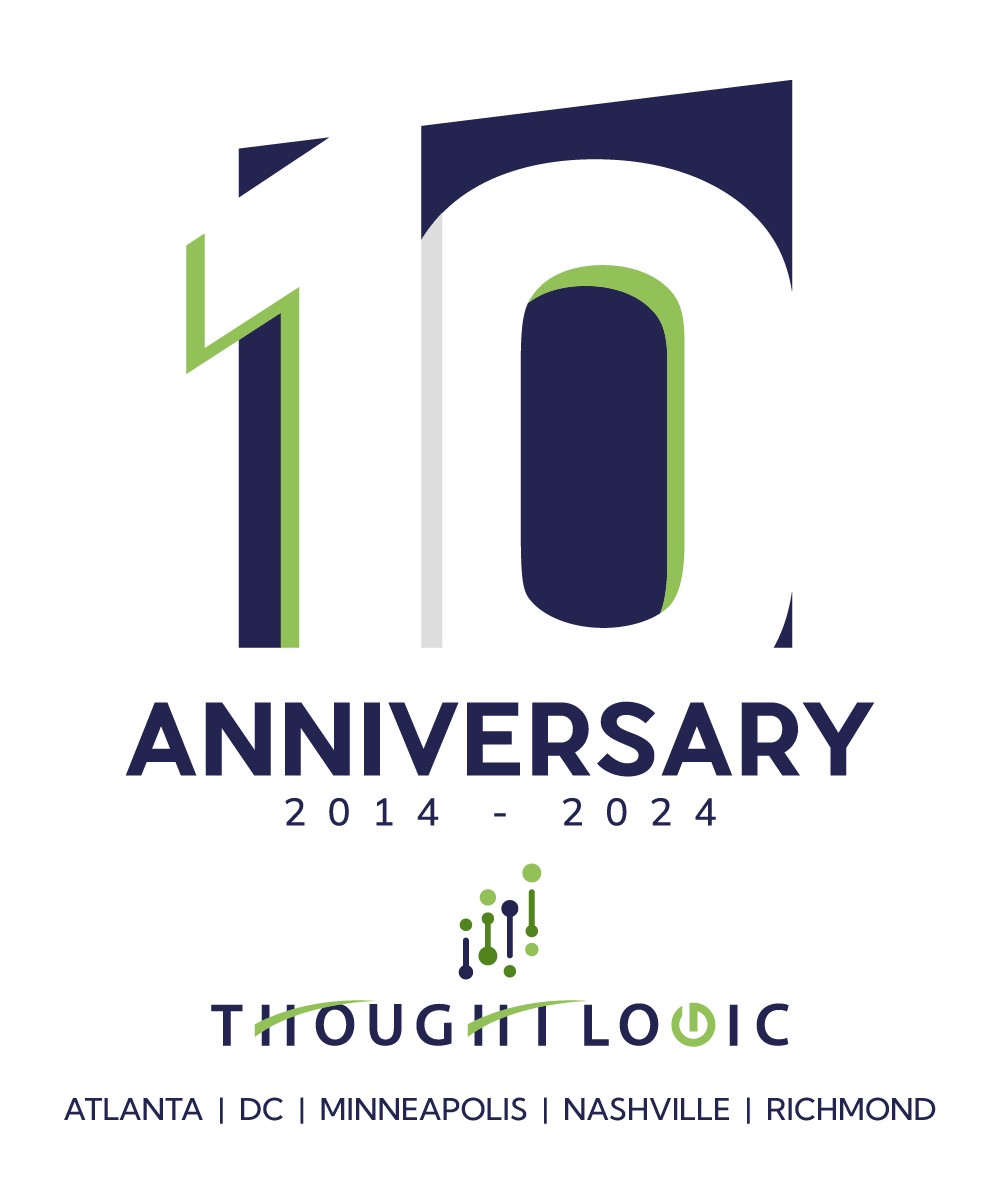
Skills-based Talent Planning: Insights and Strategies to Prepare Your Organization for the Future of Work
Q4 2023
Thought Logic’s quarterly report, People & Change Insider, offers leaders key takeaways and considerations based on the latest talent and change management trends.
Overview
Traditionally, organizations have been structured around jobs. Skills-based talent planning shifts the emphasis from job titles to a more dynamic and adaptable approach centered around the skills and competencies needed to achieve organizational goals. Essentially, each individual is a composition of skills rather than viewing them as their one overall function.
Function-Based
Human Resources Business Partner
Skills-Based
- Networking & Relationship Building
- Business Acumen
- Communication & Collaboration
- Advocacy
- Strategic Planning
- Analyzation
- Digital Literacy
- Ability to Address & Influence
Ultimately, skills-based talent planning is a strategic investment in your organization’s growth, competitiveness, and employee satisfaction. By adopting this planning approach, your organization will be better equipped to navigate the challenges and opportunities that lie ahead by leveraging increased agility, efficiency, and innovation.
Key Takeways
- A rapidly changing business landscape is pushing organizations to strategize how to prepare for the future of work.
- Businesses are challenged to put their people and their skills at the center of their talent management strategies, because it enables them to meet today’s most critical organizational objectives: organizational agility, growth, and innovation; diversity, inclusion, and equity; and the ability to offer a positive workforce experience for people.
- There are four focus areas for employers to consider to start preparing their organization to move to skills-based talent planning:
-
- Start a Cross-Functional Dialogue
- Define Foundational Skills for Your Organization
- Develop an Organization-wide Skills Rubric
- Start Small in a Critical Area
Here’s the Situation
INSIGHTS
Skills-based talent planning enables organizations to:
- Identify specific skills required for various roles to help attract and retain top talent
- Ensure employees possess skills needed to meet current and future business needs
- Facilitate the workforce’s ability to innovate, adapt to new technologies, and drive continuous improvement within the organization
- Deploy human capital more nimbly and efficiently leading to increased productivity
- Promote DEI by ensuring that hiring and development efforts are focused on a broader range of skills and experiences, rather than relying on traditional, potentially biased hiring criteria
This planning approach helps prepare for uncertainties within the business environment similar to those listed in the table to the left.

What Actions Can Leaders Take to Start Skills-Based Talent Planning?
Moving to a skills-based talent planning requires new ways of thinking and working for an organization. Depending on an organization’s size, this may be a significant change that takes several years to fully implement. Therefore, planning for organizational change is needed.
All journeys start somewhere. Provided below are considerations for strengthening your company’s skills-based talent planning.
1. Start a Cross-Functional Dialogue
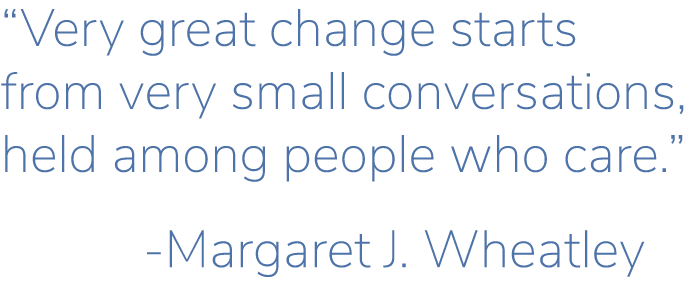
INSIGHTS
- Whether starting with organization-wide or team-sized ambitions, incorporating skills-based talent planning requires collaborative effort across departments because multiple teams will be making an investment.
- Teams to consider for a cross-functional dialogue may include Managers and Team Leaders, Human Resources, Training & Development Specialists, Finance Managers, Change Management Team, etc.
- Leaders interested in fostering a skills-based approach can start within a functional area to start building a business case.
RECOMMENDED ACTONS
- Identify the key stakeholders that should be involved with skills-based talent planning and begin sharing interest in this initiative
- Call a meeting of these key stakeholders to initiate a cross-functional dialogue to map out the skills needed now and in the future; this will help identify any skills gaps and develop strategies to bridge them
2. Define Foundational Skills for Your Organization
Research identified 56 foundational skills that will help citizens thrive in the future of work.
56 Deltas1 across 13 skill groups and four categories
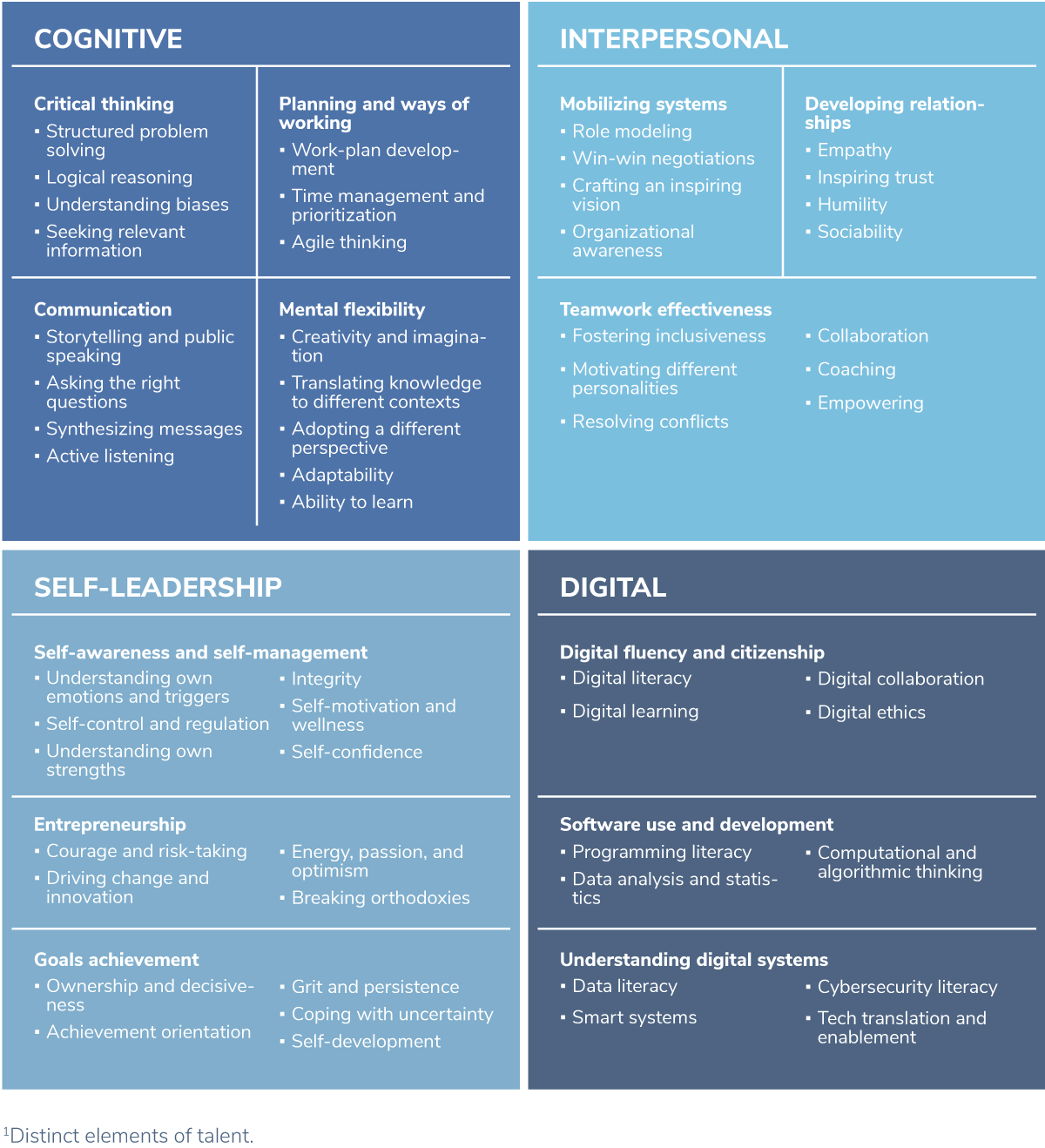
Source: McKinsey
RECOMMENDED ACTONS
- Identifying a set of foundational skills, or competencies, can help hiring managers–no matter the team–select candidates that can operate well and continually adapt to new ways of working.
- For example, McKinsey defined what foundational skills may look like based on their research (see graphic).
- Each organization is different though, so foundational skills should be tailored for best fit for the organization.
RECOMMENDED ACTONS
- Identify skills and categories that are relevant for the organization
- Validate draft foundational skills with key stakeholders
- Educate hiring managers on assessing foundational skills during the hiring process
- Work with learning and development teams to target training in these areas
3. Develop an Organization-wide Skills Rubric
INSIGHTS
- A skills rubric, or assessment, is a process used to evaluate an individual’s abilities, knowledge, and competencies in a particular area.
- By developing an organization-wide rubric on skill proficiency levels, individuals’ capabilities can measure across the organization.
- There are multiple ways to assess and verify an individual’s skills (see graphic) that vary in time and energy required as well as have different pros and cons.
- While credentials are most often used to assess skills, peer or manager feedback can help evaluate interpersonal and self-leadership skills, which are valuable for managers and leaders.
RECOMMENDED ACTONS
- Understand the skills to be assessed and choose the right assessment method
- Agree upon a rubric for employee skill assessment (see below example).
- The employee doesn’t even know what this is.
- The employee has done this a few times and is familiar, but certainly not an expert.
- The employee has done this multiple times and can do this well.
- The employee has done this in multiple companies, industries, and business cases and can design and lead a project.
- The employee is a global expert at this and could “write the book” or “teach a class” on this.
- Begin assessing employee skills by having the employee’s people manager, functional operations manager, and Human Resources each assess the employee using the rubric. These parties should discuss and align on the combined rankings.
- Continue assessments for the full team and make informed talent planning decisions.
4. Start Small in a Critical Area
INSIGHTS
- Most organizations begin by investing in learning and development, internal mobility, and talent acquisition, because these areas already have a solid understanding of skills and skills planning.
- To optimize the skills planning process, leverage technologies that are a part of existing HR information systems, such as talent marketplaces.
- Additionally, consider initiating skills-based talent planning in a small area that is critical to future operations, such as IT, to build business case.
RECOMMENDED ACTONS
- Identify which areas/teams to initiate skills based planning and what stakeholders need to be aligned to move forward
- Approach skills-based talent planning with a mindset of evolution, not revolution
- Track the pilot group’s success to further this initiative across the organization
Links to related articles and more
Building tomorrow’s skills-based organization
To explore how leaders are thinking about a shift from traditional jobs to skills-based work, Deloitte conducted both quantitative and qualitative research with workers, executives, and HR leaders across industries and around the world.
The skills-based organization: A new operating model for work and the workforce
The most fundamental building block of work—the job—could be hampering many organizations. Instead, many are now applying skills-based models to meet the demand for agility, agency, and equity.
Defining the skills citizens will need in the future world of work
To future-proof citizens’ ability to work, they will require new skills—but which ones? A survey of 18,000 people in 15 countries suggests those that organizations may wish to prioritize.
Getting rid of degree requirements means changing a lot more than job-posting languageI
If you’re trying to hire for skills, you’ll need to make changes to your promotions, pay, and culture, too.
How To Effectively Assess Employee Skills: A Beginner’s Guide
As an employer, knowing where to start, what assessment tools to use, and what skills to measure can be challenging. In this article, Upwork will explore the steps to effectively assess employee skills and provide actionable tips to help conduct an efficient employee evaluation.

About People + Change
Thought Logic’s People + Change smartSolution helps businesses reimagining the power of people to excel in an environment of continuous change.

Sign up to receive future Insights in your email box.
Never miss an update.



